Water Cycle with 12 Practice Worksheets
The water cycle is how water moves through Earth and the air. It helps water flow everywhere, so all living things can survive. Let’s learn how the water cycle works and how water keeps moving around the planet.
What is water cycle or hydrological cycle?
Let's look into the water cycle diagram given below.
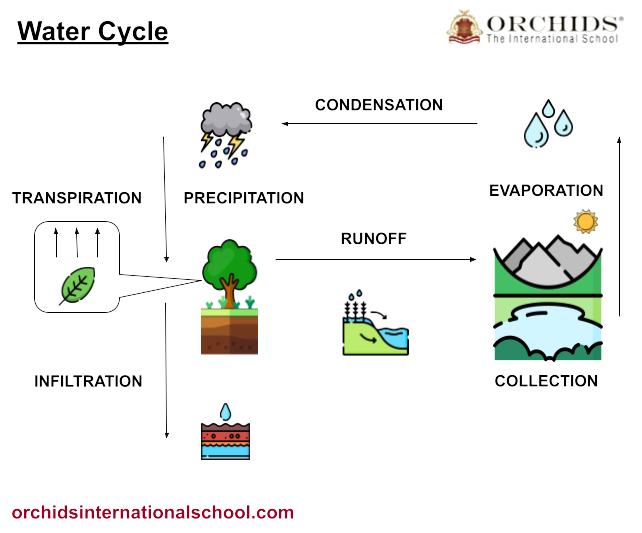
The diagram describes the main processes included in water cycle.
Test Your Understanding
1. What is water cycle?
a) A machine that produces water.
b) The movement of water on, above, and below (infiltration) Earth’s surface.
c) The process of water turning into ice.
d) A system for cleaning rivers.
What is the process of the water cycle?
Evaporation: It is the process that initiates the water cycle.
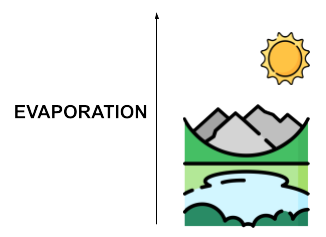
The sun will heat water in rivers, lakes, and oceans. Such heating turns the water into vapor, like invisible steam, which rises into the air.
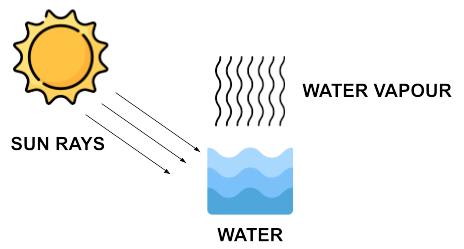
Transpiration: Transpiration, like evaporation, occurs in plants. Plants absorb water from the soil and release some vapor through small pores on the leaves. This contributes water vapor to the air as well.
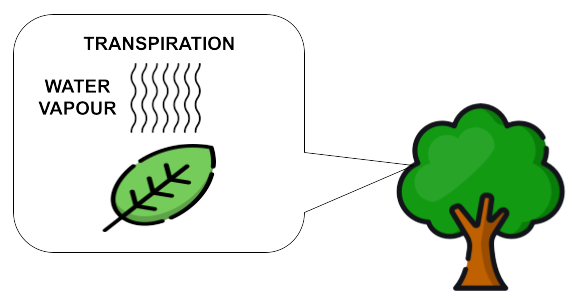
Condensation: As the water vapor rises into the sky, it cools down to form small droplets again. They combine in the air to form clouds. In such a process, the water vapor changes into droplets and fall back to the Earth in the form of rain. This process is called condensation.

Precipitation: Once the clouds hold too much water in the droplets, they can't retain them. The water falls back to the Earth as precipitation such as rain, snow, or hail.

Runoff: When it rains, some waters flow over the grounds and find their way into rivers, lakes, or oceans. The moving water is runoff.
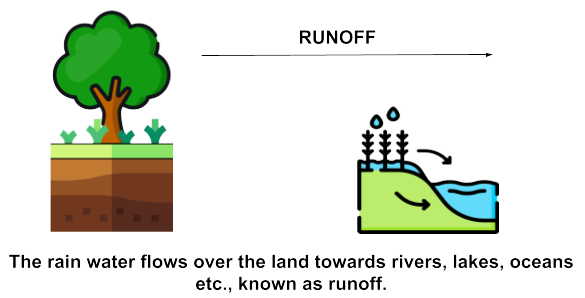
Infiltration: Not all the water remains on the surface. Some of it goes into the soil through a process called infiltration. This water fills the underground cavities, and it forms something called groundwater.
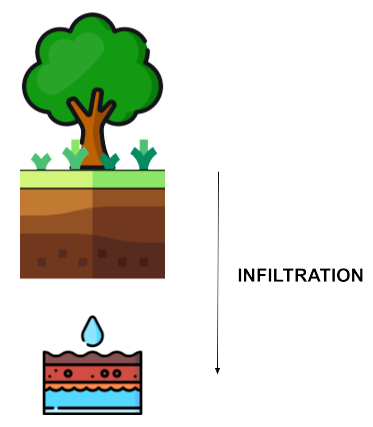
Collection: All water finally collects itself in rivers, lakes, and oceans. This process is called collection, and this is where the water cycle repeats itself once again.
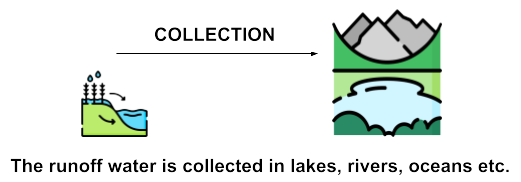
These are the main processes involved in water cycle.
Test Your Understanding
1. Which process causes water to fall from the sky as rain, snow, or hail?
a) Evaporation
b) Collection
c) Precipitation
d) Condensation
2. In which process does water move from plant leaves into the air?
a) Precipitation
b) Evaporation
c) Transpiration
d) Collection
Why water cycle is important?
The water cycle is important for life on Earth. It provides water to all living things and helps control the weather. Its importance is stated below:
.1. Gives us fresh water for drinking: It is the reason why, when water moves from the oceans to the land, it provides us with clean water. The water must remove salt for it to evaporate, meaning that rainwater becomes fresh and safe to drink. (Fresh water is water with minimum salt. Example - river, ocean. And, salt water is water which has much more salt than fresh water. Example - sea.)
2. It helps the vegetation: Water is essential for the existence of plants. And water cycle is a natural way to bring that water to them in the form of rain. Without it, we would have no trees, flowers, or even food crops.
3. It refills lakes, rivers, and oceans: Rain and runoff from the water cycle refill lakes, rivers, and oceans which serve as homes for fish, turtles, and other water-living animals. (Want to know more about the different sources of water that water cycle affects? Click here)
4. It controls earth's temperatures: The water cycle distributes heat across the Earth. For example, Evaporation cools the earth, and the release of heat happens during condensation thus managing temperature levels.
5. It naturally purifies water: As water moves through the water cycle, it gets purer. Evaporation removes impurities from water, and as infiltration happens that's when water absorbs into the ground-water is purified even more by the soil.
Test Your Understanding
1. Why is the water cycle important for life on Earth?
a) It stops rain from falling.
b) It provides water for plants, animals, and people to survive.
c) It makes clouds disappear.
d) It turns rivers into deserts.
2. How does the water cycle help plants?
a) It keeps the soil dry.
b) It provides water for plants to make food and grow.
c) It stops plants from growing.
d) It removes sunlight needed for plants.
Think About It!
1. What powers the Water Cycle?
Ans: The sun is the main source of the water cycle. It provides heat energy to aid evaporation. The sun also helps water in moving on its continuous journey.
2. How does pollution affect the water cycle?
Ans: Pollution can harm the water cycle by:
-
Pollution makes the water dirty, which can harm animals, plants, and all living beings.
-
Adding chemicals that make rainwater unsafe.
-
Warming the Earth (through climate change), can cause too much evaporation or reduce rainfall in some areas.
3. What will happen if the water cycle stops?
Ans: If the water cycle stopped:
-
Living beings wouldn’t have fresh water to drink or grow food.
-
Plants, animals, and human beings wouldn’t survive. Without the water cycle, life on Earth would come to an end.
-
Rivers, lakes, seas, and oceans would dry up. This would bring disaster for all life on Earth.
-
Lack of rain will create famine across the globe leading to massive starvation.
4. How can we protect our water cycle?
Ans: Pollution and climate change can harm the water cycle by making rainwater dirty or changing weather patterns. Here’s how you can help:
-
Don’t waste water: Turn off taps when not in use.
- Protect Natural Storage of Water: Encourage Rainwater Harvesting. (Check this video on Rainwater Harvesting)
-
Recycle and reduce waste: Less waste means less pollution.
-
Plant trees: Trees release water vapor into the air (Transpiration), helping the cycle.
Quiz
1. Why is the water cycle important?
a) It makes clouds disappear
b) It keeps water clean and moving for life on Earth
c) It makes water stay in one place
d) It stops rain from falling
2. What happens during evaporation?
a) Water changes into ice
b) Water changes into vapor and rises into the air
c) Water flows into rivers
d) Water turns into rain
3. During __________, water vapor cools and turns into tiny droplets to form clouds.
a) Evaporation
b) Condensation
c) Infiltration
d) Transpiration
4. What do we call water falling from clouds as rain, snow, or hail?
a) Collection
b) Evaporation
c) Precipitation
d) Condensation
5. Where does water go after precipitation?
a) It only evaporates
b) It is collected in rivers, lakes, and oceans
c) It stays in the clouds
d) It disappears completely
6. What is the final step in the water cycle?
a) Evaporation
b) Collection
c) Condensation
d) Precipitation
Practice Worksheets
Click the button to download the worksheets for hands-on practice!
Easy Level Worksheets
Intermediate Level Worksheets
Advanced Level Worksheets
Orchids' Learning Material
Click the button to download the e-book
Things you have learnt!
- The water cycle is a natural process that moves water around Earth, giving us rain, rivers, and clean water to use.
- It helps plants grow, fills lakes and rivers for animals to drink from, and provides water for us to cook, clean, and stay healthy.
- The different processes of water cycle and it's importance.
- The water cycle ensures that life on Earth continues to thrive.

